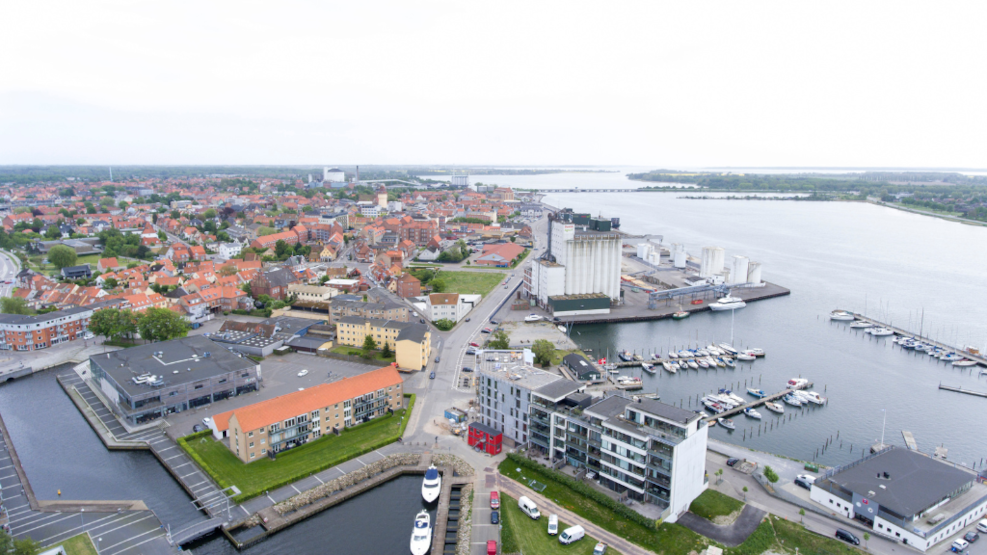
Nykøbing Falster
Discover Lolland-Falster's largest city with cosy shopping, history, art and folk meeting.
Nykøbing Falster is a charming market town steeped in royal history, beautifully situated by Guldborgsund. The town offers everything from cozy streets lined with shops, cafés, and galleries to concerts in the square and Denmark's second-largest revue, as well as a stroll in the footsteps of Queen Sophie.
Markets, Concerts, and Madens Folkemøde
Explore the town’s cozy streets and visit the town square, which hosts concerts, markets, seasonal events, a Christmas market, and large screen events. The square also features cafés where you can enjoy the view of the iconic Bjørnebrønden fountain.
In 2025, Madens Folkemøde (The People's Food Summit) will make its debut in Nykøbing Falster. From Klosterkirken to Hollands Gaard, and throughout the square and streets, the town will be alive with stalls, food markets, tastings, producers, debates, talks, presentations, fun activities, and much more.
A Haven for Culture and History Enthusiasts
The town was built around Nykøbing Falster Castle, where Queen Sophie, mother of Christian IV and widow of Frederick II, once resided. Queen Sophie was a skilled entrepreneur and businesswoman, becoming the wealthiest woman in Northern Europe through her efforts. Over time, she played a significant role in the development of the town and the region, including improving the management of local estates.
The castle was demolished in 1763, and its materials were repurposed to construct manor houses on Lolland-Falster. Today, you can feel the historical atmosphere by walking in Queen Sophie’s footsteps through Nykøbing Falster. The walk includes ruins of the castle, cobblestones marking its location, and several preserved stables and storehouses once associated with the castle.
For art enthusiasts, the town features two art trails, showcasing works like Henrik Heerup’s Swan Mother, Anette and Michael Arleth’s Sky Bird, and sculptures by Thomas Kadziola, who also created the monumental Dodekalitten.
The Sugar Beet – Lolland-Falster’s “White Gold”
A walk through Nykøbing Falster during winter is accompanied by the distinctive scent of sugar production from Nykøbing Falster Sugar Factory.
Known locally as “white gold,” sugar has been integral to Lolland-Falster since the 19th century. The region is home to Denmark’s finest—and most expensive—farmland, ideal for cultivating sugar beets. The first Danish sugar factory opened on Lolland, and the factory in Nykøbing Falster, established in 1884, is now one of only two remaining in Denmark. Together with Nakskov’s factory, they produce over 400,000 tons of sugar annually.
If you’re curious about sugar production, tours of the Nykøbing Falster Sugar Factory are available in November, where former employees share insights into the process.
The Future of Nykøbing Falster
Exciting development plans are underway for Nykøbing Falster, with the ambition to transform the harbor into a vibrant and green district connected to the city center. The vision includes a new cultural center, hotel, museum, market hall, office spaces, housing, a harbor bath, green areas, and facilities for water sports.
Beyond the harbor, other parts of the town, particularly the southern area, are seeing new residential developments, offering apartments and row houses close to green spaces, water, and the city.
The upcoming opening of the Fehmarn Belt Tunnel is a gamechanger for Lolland-Falster, including Nykøbing Falster. The tunnel will connect Denmark and the rest of Scandinavia to Europe, opening up new opportunities and collaborations. A new railway line is also being built to link Scandinavia and Europe, including the expansion of King Frederik IX’s Bridge, connecting Lolland and Falster, with an additional railway track.